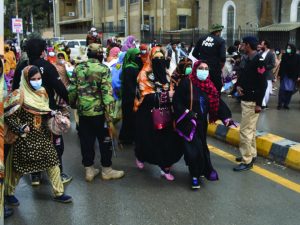Energy shortage in Balochistan
Ajmal khan
Poverty is not a static or fixed phenomenon.It is a multi-dimensional idea that encompasses quality in almost every sphere of life, ranging from calorie intake, life expectancy, living standards, literacy, and access to modern energy services. This type of poverty is always expressed from an income perspective. Sticking with the non-income dimensions of poverty, such as health, education and living standards, are as important as employment.
The two energy indicators of non-income dimensions, including electricity (no access to electricity) and cooking fuels (wood, dung and charcoal), constitute poverty. Goal no. 7 of SDGs contains universal access to modern energy services, increasing energy efficiency, and increasing renewable energy share. As we know, energy plays a vital role in the development process of a country, but incase of Pakistan, energy poverty is the largest single drain on Pakistan`s economy.
When we talk about Balochistan, it is the direct and major victim of energy crisis, and has slowed down the growth of the province. Balochistan is the largest province of Pakistan,having an area of 347,190 km square and a population of 12,344,408 people. The major portion of the population live in rural areas, constituting 72.45%.
Only 36 Percent of Balochistan has access to energy:
Balochistan is facing an acute energy shortage that has stopped the development not only in the economic and agriculture sector, but also in every walk of life. According to a document submitted to the National Assembly of Pakistan, only 36% of Balochistan is electrified, while the remaining 64% of Balochistan still doesn’t have access to energy. Due to the scattered population living in rural areas, it is impossible to electrify them. In 2018, the total demand of Balochistan was 1650 MW, but supply was limited to 600 MW, and in 2019 the demand has been raisedto 2500 MW.
Energy Projects in CPEC:
Energy is the prominent component of China Pakistan Economic Corridor (CPEC). Almost 70% of the CPEC projects were related to the energy sector,which comprises thermal, hydral, coal and wind. Unfortunately, Balochistan is being left out of these projects. Out of 13 mega projects related to energy, six projects are being located in Punjab, six in Sindh and one in Khyber Pakhtunkhwa. Once again, the energy-starved and downtrodden province has been ignored and not given its due share to fulfil its energy demands.The energy generated by these projects will not give any relief to the consumers in Balochistan.
The already installed transmission lines are inadequate, and the province does not have the capability and capacity to absorb energy beyond 500 MW. The two transmission lines worth $4 billion will run from Matiari to Faisalabad and Lahore, respectively. These transmission lines are providing 4000 MW to Punjab. Looking at this picture, the overall situation in rural Balochistan is worse, where 85% of the population lives and some areas in Balochistan are not even linked with the national grid systems. This is an alarming situation where a major portion of the population still doesn’t have access to electricity, and it will further deteriorate the growth of the province.
Energy Production in Balochistan:
Balochistan is producing about 2422 MW of electricity using gas-based thermal. Almost all the electricity generated in the province is being transmitted to other provinces. Electricity has been purchased by QESCO from two autonomous power producers include the Uch power plant and Habibullah Coastal Power plant. The province also receives electricity from Iran and provides it to the areas along the border. The federal government initiative to reduce load-shedding will not positively impact the province because the existing transmission lines are not that much capable of supplying any load beyond 600 MW. There is not a single 500 kV grid station in the province.
No doubt, it is impossible to provide and extend transmission lines to the far-flung areas because it will cost too much. The electricity demand in rural areas of Balochistan is very low and the houses in rural areas need only lighting for roomed huts built of mud. Furthermore, investors feel hesitant to invest in the province due tolack of infrastructure, revenue generation and security.
Considering all these factors, solar energy remains the best source because Balochistan receives the largest solar radiance in its area. According to a World Bank assessment, Balochistan receives the highest average sunlight in the world, which makes it rich in solar energy. Keeping in view these factors and in spite of extending the transmission lines to the far-flung and remote areas, the government should provide a solar panel to each house that is more economical and cost efficient. It will empower the socio-economic conditions of the population living in rural areas.
The Wind Corridor of Balochistan and Government’s efforts:
Besides solar energy, the wind energy is another essential source and Balochistan has been blessed with a high rate of wind speeds. The Pakistan Meteorological Department (PMD), in their shared data, suggested that the wind speed in the coastal area of the province is enough to generate electricity. In this line, Pakistan Council of Renewable Energy Technologies (PCRET) has electrified 1600 villages along the coastal side of Sindh and Balochistan. A study suggested that the coastal belt of Pakistan can produce 50,000 MW through wind resources. To minimize the cost of these projects,the government should encourage local manufacturersof wind turbines.
In this regard, to overcome the energy poverty in Balochistan, the federal government can play a vital role in alleviating energy poverty by using renewable energy resources in electrifying the rural areas of Balochistan.keeping in view the solar radiance and wind speed,there is a huge potential forrenewable energy in the province. They should not electrify the far-flung areas with conventional grid-based methods because it will maximize their cost as the traditional modes of energy are expensive, and in the longrun, it cannot meet the energy demand for sustainable development. The government should provide the due share in CPEC related energy projects
to the province. Suppose the issues related to energy poverty are not taken seriously, the dream of achieving SDGs will never be achieved, and the already poverty-stricken province will observe more difficulties in the coming days.
The author is a research officer, member of Balochistan Think Tank Network.






1 comment